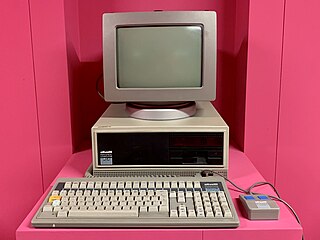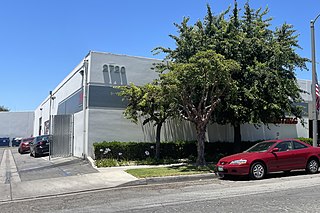
The Extended Industry Standard Architecture is a bus standard for IBM PC compatible computers. It was announced in September 1988 by a consortium of PC clone vendors as an alternative to IBM's proprietary Micro Channel architecture (MCA) in its PS/2 series.

Industry Standard Architecture (ISA) is the 16-bit internal bus of IBM PC/AT and similar computers based on the Intel 80286 and its immediate successors during the 1980s. The bus was (largely) backward compatible with the 8-bit bus of the 8088-based IBM PC, including the IBM PC/XT as well as IBM PC compatibles.

The Intel 386, originally released as 80386 and later renamed i386, is a 32-bit microprocessor designed by Intel. The first pre-production samples of the 386 were released to select developers in 1985, while mass production commenced in 1986. The processor was a significant evolution in the x86 architecture, extending a long line of processors that stretched back to the Intel 8008. The 386 was the central processing unit (CPU) of many workstations and high-end personal computers of the time. The 386 began to fall out of public use starting with the release of the i486 processor in 1989, while in embedded systems the 386 remained in widespread use until Intel finally discontinued it in 2007.

The Amiga 2000 (A2000) is a personal computer released by Commodore in March 1987. It was introduced as a "big box" expandable variant of the Amiga 1000 but quickly redesigned to share most of its electronic components with the contemporary Amiga 500 for cost reduction. Expansion capabilities include two 3.5" drive bays and one 5.25" bay that could be used by a 5.25" floppy drive, a hard drive, or CD-ROM once they became available.

The Personal System/2 or PS/2 is IBM's second generation of personal computers. Released in 1987, it officially replaced the IBM PC, XT, AT, and PC Convertible in IBM's lineup. Many of the PS/2's innovations, such as the 16550 UART, 1440 KB 3.5-inch floppy disk format, 72-pin SIMMs, the PS/2 port, and the VGA video standard, went on to become standards in the broader PC market.

Compaq's first computers' form factors were portable, also called "luggables", and then "lunchbox computers", and together constituted the Compaq Portable series. These computers measured approximately 16 inches (410 mm) deep, 8 inches (200 mm) tall, and approximately 20 inches (510 mm) wide. As the products evolved, laptops and notebooks were created offing a new level of portability that caused the market to explode.
During the late 1980s, Intel sold two ISA expansion cards named Intel Inboard 386/AT and Intel Inboard 386/PC, which allowed users to upgrade an IBM AT or an IBM PC respectively. The boards allowed users to upgrade their machines' CPU to a 16 MHz 80386 processor. Both variants utilized a ribbon cable which plugged into the computer's original CPU socket on one end and into a socket on the Inboard card on the other end.

The LTE is a line of laptops manufactured by Compaq Computer Corporation, introduced in 1989 and discontinued in 1997. It was the first notebook-sized laptop sold by Compaq and the first commercially successful notebook computer, helping launch the burgeoning industry.

The Compaq Deskpro is a line of business-oriented desktop computers manufactured by Compaq, then replaced by the Evo brand in 2001. Models were produced containing microprocessors from the 8086 up to the x86-based Intel Pentium 4.
The Commodore PC compatible systems are a range of IBM PC compatible personal computers introduced in 1984 by home computer manufacturer Commodore Business Machines.

The Olivetti M24 is a computer that was sold by Olivetti in 1983 using the Intel 8086 CPU.

The IBM Personal Computer XT is the second computer in the IBM Personal Computer line, released on March 8, 1983. Except for the addition of a built-in hard drive and extra expansion slots, it is very similar to the original IBM PC model 5150 from 1981.

The SLT is a family of laptops released by Compaq Computer Corporation. The SLT was the first laptop ever released by Compaq, then primairly known as a maker of luggable and desktop computers. The SLT series was the successor to the Portable III and the predecessor to the more well-known LTE.

American Computer & Peripheral, Inc. (AC&P), also written as American Computer and Peripheral, was an American computer company based in Santa Ana, California. The company was founded in 1985 by Alan Lau and released several expansion boards for the IBM PC as well as a few PC clones before going bankrupt in December 1989. Obscure in its own time, the company's 386 Translator was the first plug-in board for Intel's newly released 80386 processor and the first mass-market computing device to offer consumers a means of using the 386 in July 1986.

Advanced Logic Research, Inc. (ALR), was an American computer company founded in 1984 in Irvine, California by Gene Lu. The company marketed IBM PC compatibles across that standard's evolution until 1997 when it was acquired by Gateway 2000.

The Personal System/2 Model 30 and Personal System/2 Model 30 286 are IBM's entry-level desktop computers in their Personal System/2 (PS/2) family of personal computers. As opposed to higher-end entries in the PS/2 line which use Micro Channel bus architecture, the Model 30 features an Industry Standard Architecture bus, allowing it to use expansion cards from its direct predecessors, the PC/XT and the PC/AT. The original PS/2 Model 30 is built upon the Intel 8086 microprocessor clocked at 8 MHz; the Model 30 286 features the Intel 80286 clocked at 10 MHz.

The Personal System/2 Model 25 and its later submodels the 25 286 and 25 SX are IBM's lowest-end entries in the Personal System/2 (PS/2) family of personal computers. Like its sibling the Model 30, the Model 25 features an Industry Standard Architecture bus, allowing it to use expansion cards from its direct predecessors, the PC/XT and the PC/AT—but not from higher entries in the PS/2 line, which use Micro Channel. Unlike all other entries in the PS/2 line, the Model 25 and its submodels are built into an all-in-one form factor, with its cathode-ray tube (CRT) monitor and system board occupying the same enclosure. IBM oriented the Model 25 at home office workers and students.

Aox Inc. was a privately run American technology corporation founded by Michael and Linda Aronson in 1978. Over the course of its 22-year lifespan, the company chiefly developed software and hardware for IBM's PC and compatibles, for the Personal System/2, and for the Macintosh. In its twilight years, the company designed multimedia and teleconferencing devices and chip designs. Aox was founded after Michael Aronson graduated from Harvard University with a doctorate in physics; he stayed with the company until 2000, when he incorporated EndPoints Inc. and switched to full-time fabless semiconductor design.

Cumulus Corporation was an American computer peripheral and system manufacturer active from 1987 to 1993. Based in Beachwood, Ohio and started by Tecmar founder Martin Alpert, the company set out to exclusively manufacture expansion products for IBM's Personal System/2 (PS/2) family of computers—mainly RAM expansion cards. It later released cross-platform CPU upgrade cards and memory expansion cards for other platforms besides the PS/2. Beginning in 1990, the company began trading as Cumulus Computer Corporation and began releasing complete systems of their own. Initially a success story for the tech industry in Cleveland, a botched stock launch in 1992 proved disastrous for the company's ailing cash flow situation, and in 1993 the company was liquidated amid massive debt to suppliers and lenders.

The LTE, LTE/286, and LTE/386s were a series of notebook-sized laptops manufactured by Compaq from 1989 to 1992. The three laptops comprise the first generation of the LTE line, which was Compaq's second attempt at a laptop following the SLT in 1988 and their first attempt at a truly lightweight portable computer. The LTE line proved highly popular—Compaq selling hundreds of thousands of units between the three—and gave way to successive generations of the line, including the LTE Lite, the LTE Elite, and the LTE 5000 series. With its use of industry-standard floppy and hard drive technologies, the LTE was the first commercially successful notebook computer and helped launch the fledgling notebook industry, which had seen earlier attempts fail due to the use of novel but nonstandard data storage.



















